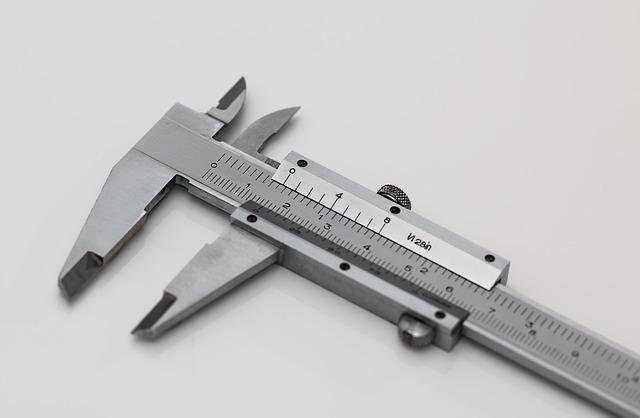Vernier Caliper is a measuring instrument that is used to take the dimensions of objects whether the dimension is linear or measuring the diameter of round objects.
Vernier Caliper is invented by French mathematician Pierre Vernier in 1631. The main use of the vernier caliper over the main scale is to get precise and accurate measurements.
Vernier caliper consists of two scales: the main scale and the other is called the vernier scale. Vernier scale can slide over the main scale. Vernier caliper is made of either tool steel or stainless steel, depending on the application where we have to use it.

Least Count of Vernier Caliper
The least count of the Vernier caliper is defined as the minimum length that can be measured with the vernier scale. The least count of vernier calipers is also defined as the difference between one main scale division and one vernier scale division.
It is mathematically given as:
Least count= 1 MSD – 1 VSD
n VSD = (n-1) MSD
1 VSD = (n-1) MSD / n
Least count= 1 MSD – 1 VSD
Therefore, Least count = 1 MSD – (n-1)MSD/n
After calculation, Least count = 1 MSD/n
Total reading = MSR+ (VC X LC), where MSR is the main scale reading, VC is the Vernier coinciding division and LC is the least count.
Vernier Caliper Parts
- Main Scale
- Vernier Scale
- Lower Jaws
- Upper Jaws
- Depth Rod
- Lock screw
- Thumb Screw
Let us look at the function of all the parts one by one:
Main Scale
The main scale is not movable or we can say it is stationary. The least count on the main scale is 1mm as per SI units. It is the large scale that runs along the body of the vernier caliper.
Vernier Scale
Vernier scale is the smaller scale that is attached to the body of the main scale. This scale runs along with the body of the main scale. The vernier scale is used to provide the accuracy of the reading to the main scale reading. The vernier scale is a metric caliper that has divisions of 50 increments and each division measures 0.02 mm.
Lower Jaws
The lower jaws are the best feature of the vernier caliper. One of the jaws is fixed with the main scale and the second jaw is movable and is attached to the vernier scale. The main function of the jaws is to measure the outside diameter of the object such as length, and diameter.
Upper Jaws
These are similar to the lower jaws but the size is small. One of the jaws is fixed with the main scale and another jaw is movable. The main function of these jaws is to measure the inner diameter of the object. For example, the inner diameter of hollow pipes can be measured with upper jaws.
Depth Rod
The depth rod is used to measure the depth of the object and can be found at the end of the main scale. For measuring the depth, the edge of the main scale is placed at the object. Then jaws are opened and the depth rod travels inside the object and stops until it touches the end of the object. Then read the reading.
Lock Screw
The lock screw is used to lock the jaws so that they could not move. This is used to measure the accurate readings.
Thumb Screw
The thumb screw is used to provide grip to the user so that taking reading by sliding would be easy. The thumb screw is located at the bottom of the caliper.
How To Use Vernier Caliper
As shown in the image, there are two jaws. One is a fixed jaw and the other is a movable jaw. A movable jaw can slide over the mail scale for its entire length. A clamping screw is shown in the image which is used in locking the movable scale so that a person can get an accurate value while measuring the dimensions.
There is a depth measuring blade as well to measure the depth of the objects which is an important feature of the vernier caliper.
It is very easy to use the vernier caliper. You just have to follow the steps given below:
To Calculate the outside diameter of the object:
- First of all, check the reading on the vernier caliper should be zero when both jaws are closed. In this case, the extreme left line on the main scale and extreme left line on the vernier scale should coincide with each other.
- Then open the lower jaws and put the object in between those jaws and close the jaws.
- Once the jaws are closed, lock the movable scale with the help of a locking screw.
- Then check the main scale reading and note it down.
- After that, match the vernier scale reading with the main scale reading and note it down.
- Add up these two values and it will be your final reading.
To Calculate the inside diameter of the object:
- First of all, check the reading on the vernier caliper should be zero when both jaws are closed. In this case, the extreme left line on the main scale and extreme left line on the vernier scale should coincide with each other.
- Then open the upper jaws and put the object in between those jaws as shown in the image and close the jaws.
- Once the jaws are closed, lock the movable scale with the help of a locking screw.
- Then check the main scale reading and note it down.
- After that, match the vernier scale reading with the main scale reading and note it down.
- Add up these two values and it will be your final reading.
To Calculate the depth of the object:
- First of all, check the reading on the vernier caliper should be zero when both jaws are closed. In this case, the extreme left line on the main scale and extreme left line on the vernier scale should coincide with each other.
- Then open the jaws and the depth measuring blade will get extended. This blade should go inside the object where we can measure the depth.
- Once the blade reached the extreme end of the object, lock the movable scale with the help of a locking screw.
- Then check the main scale reading and note it down.
- After that, match the vernier scale reading with the main scale reading and note it down.
- Add up these two values and it will be your final reading.
Frequently Asked Questions
What is a vernier caliper used for?
Vernier Caliper is used to measure the distance between two points. Also, it is used to measure the outside diameter, inside diameter, and depth of an object.
What are the three uses of the vernier caliper?
Vernier caliper is used to measure the following three things:
1. To measure the outside diameter of an object
2. To check the internal diameter of an object
3. To check the depth of an object
What is the least count of Vernier caliper?
The least count of vernier caliper is .1mm.
What is Vernier Caliper least count formula?
The formula for Vernier caliper least count is given below:
Least count = Smallest reading on main scale/Number of divisions on the vernier scale
= 1 / 10 = .1 mm
If you still have any doubts or queries, kindly comment down below: We will try to clear all of your doubts.

1 thought on “Vernier Caliper: Diagram, Least Count, Formula”